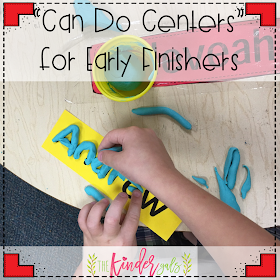Racing Rabbits
Here's how you play:- Create a board game with 3 columns.
- Make 3 game pieces. I made these rabbits by opening a paper clip to a 90 degree angle. Then, I taped it to the back of the card to make the rabbits stand up.
- Give the child a dice.
- Invite him to roll the dice.
- The child moves the rabbits that many spaces.
- He can move one rabbit ALL the spaces, OR he can split the roll between the various rabbits.
- IF you want to take it to the abstract level...invite the child to record the equation to show how he split the roll.
Measure Me
Here's how you play:
- Create a set a seasonal cards.
- To pay this game, the children work with a partner.
- One of the children lay down on the floor.
- The other child uses the cards to measure the height of the partner.
- On the recording page, the children draw a person to represent the height of the first partner.
- Repeat with the other partner.
- Finish the recording page.
Let's Take Turns
Here's how you play:
- Create a game strip with a different clip art image in the center square.
- Make ONE game piece. I used the paper clip again to make the girl stand up.
- To play this game, the children work with partners.
- Invite one child to sit at each end of the strip.
- The first child rolls the dice. Then, he moves the game piece that many squares TOWARDS himself.
- Now, it is the other partners turn to roll the dice. Then, she moves the SAME game piece that many squares TOWARDS herself.
- The goal is to see who can get the game piece off of their end of the game board.
- Want to change the standard? Just change what the children do with the dice. You can give the children two dice. Roll the dice and add or subtract the dots. Move the number of squares indicated by the sum or difference.
Number Line Races
Here's how you play:
- Create a number line 1-20.
- Collect tiny pieces to place on each numeral. I used clip art pictures.
- Make a gardener game piece. I used the paper clip to make it stand up.
- Invite the child to put the gardener at the beginning of the number line.
- Then, he rolls the dice and moves that many spaces on the number line. He removes the clip art piece on that numeral.
- The object of the game is to collect all of the clip art pieces.
- Let's say the child rolled a 5. He moves 5 spaces and removes the clip art piece on the 5.
- He rolsl again. Let's say he rolls a 3. Now, he must decide if he wants to move forward three (5 + 3) or backwards three (5 - 3). If he picks to move backwards, he would remove the clip art piece on the 2.
- Invite the children to record the number sentences that match their moves.
Number Line Mystery
Here's how you play:
- Create a deck of cards.
- The deck has 4 suits (pots, kites, birds, and umbrellas).
- For each suit, make a card without a numeral, and cards with the numerals 1-10 (or 20).
- Lay the 4 cards without a numeral in a column, face up.
- Shuffle the remaining cards and lay them facedown, in an array by placing 10-20 cards in each row.
- Invite the first child to turn over a card.
- Then, the child looks at the card, finds the row with the same suit, and then looks at the numeral on the card to determine where it belongs in the row to make a number line.
- Remove the card that is in the space and lay down the child's card.
- Take the new card and repeat the process.
- If you want to see further picture directions, this blog post has detailed pictures!

You can also grab a FREE number line game for back to school in this blog post.
















































